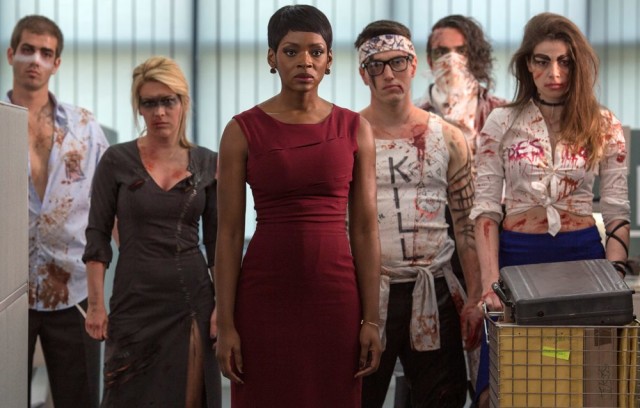I originally planned on reviewing Mayhem today. But then I watched it. And the movie is a borderline disaster. It’s one of the most overwritten over-directed movies I’ve ever seen in my life. I then rented the movie Columbus. That movie is like a delicate slice of cinematic sweetbread. It’s also one of the most underwritten under-directed movies I’ve seen in my life. So I thought it’d be fun to review these two contrasting pieces of entertainment together.
And here’s the funny part.
I’d tell each and every one of you to write the abysmal Mayhem over the brilliant Columbus.
For those who don’t know, Mayhem is about a company attacked by a virus that makes its victims succumb to their worst impulses. If you’re an angry person, it makes you extremely violent. If you’re slightly manipulative, you become a sociopath. If you’ve got sex on the brain, it turns you into a walking sex machine.
When their building is placed on an 8 hour quarantine, a recently fired employee, Derek, enacts revenge on everyone who screwed him over, teaming up with a former female client the company also screwed over, to do so.
I expected to LOVE this movie. I thought the premise was fun. It was a way to make a zombie film without making a zombie film. It had that “familiar but different” thing Hollywood’s so keen on.
But the execution was too over-the-top, as subtle as your loud inappropriate drunk uncle. On the screenplay side, half the script is dedicated to explaining the virus. Even though the opening montage is specifically built to explain every nuance of the virus, we’re still being given virus rules 40 minutes later.
Here’s something to keep in mind for new screenwriters. Exposition (the process of explaining things so that your story makes sense) is fought on two fronts. The front everyone focuses on is the “How to Limit My Exposition” front. You’re trying to minimize how much you explain everything. Which is good. You should be doing this.
But the other front, the one nobody talks about, is to simplify your plot and rules in the first place! If you build your story on top of a simple premise and simple rules, you won’t need to explain as much! By making this virus, this company, the people within this company, and the laws governing this virus, so complicated, they had no choice but to use up half the movie on exposition.
On the other end of the spectrum was Columbus.
Columbus takes place in the titular town of Columbus, Indiana, a hidden goldmine for some of the most beautiful architecture in the country. When a visiting professor of architecture falls gravely ill, his son, Jin, must fly in and wait for the doctors to figure out what to do with him. In the meantime, he meets a townie, Casey, with the potential to do something great in the world, but who’s sacrificed that opportunity to take care of her addict mother.
Talk about completely opposing plots, right? Whereas every second of Mayhem is dedicated to explaining something or killing someone, you might go 3-4 minutes at a time in Columbus without a character saying a word.
The movie is one of the most beautifully shot I’ve ever seen, so much so I tracked down interviews with the elusive director, a 50-something Korean man named Kogonada (who up until this point had only done video essays and never been on an actual movie set). Listening to him discuss his film was fascinating. His entire approach to filmmaking is to prioritize form over plot. To him, the perfect shot (of a building, a character, a lone room in a house) was far more important than two characters conversing. It’s pretty much the antithesis of what I preach. And yet it worked brilliantly for the film.
What Is Neorealism? from kogonada on Vimeo.
Granted, Kogonada has a filmmaking eye like no other. Every frame of his is a painting. Therefore, had a less talented director tried to do the same thing, I’m sure I’d have been chastising him for not focusing more on story.
With that said, Kogonada still finds a story that resonates. Remember, you can get away with simple plots as long as the themes are universal, as long as the issues are relatable. Both Jin – working a soulless corporate job that’s desensitized him to the world – and Casey – being stuck in a small town instead of going out and following her dreams – are universal conflicts that many people can identify with.
And unlike Mayhem, where the plot had to be jammed in our faces every five seconds, Kogonada used the most minimal plot device possible – a sick father who was keeping our main character stuck in town. It was a big reason why the story worked so well. The plot point that placed our characters together was borderline invisible.
With all that said, if you’re choosing between writing a Mayhem or a Columbus? I’ll tell you to write Mayhem every time. It’s got a fun hook. It’s marketable. You can imagine the movie when someone pitches it to you. It’s going to get priority over a “Columbus” like idea in every production room in town.
Not to mention, the prestige Straight-To-Digital release is an emerging avenue for spec screenwriters. I say “prestige” so it’s separated from the abysmal D-Movie efforts that Nic Cage and John Cusack star in. These prestige digital offerings are cooler, hipper, the kind of stuff that’s going to get play on movie web sites. But that means your idea needs to be cool and hip. It cannot, sadly, be Columbus.
With that said, Columbus is the perfect vehicle for a writer-director. If you have something that isn’t sexy on the page but you KNOW is going to look great on film, directing the movie yourself is the way to go. Realistically, nobody’s going to be interested in your small personal movie but you. And that’s okay. Cause plenty of these personal writing-directing efforts turn out to be great.
But if you have no interest in directing? Come on. Be smart. Write something with a hook like Mayhem.



